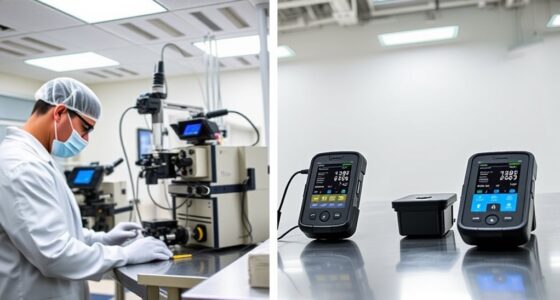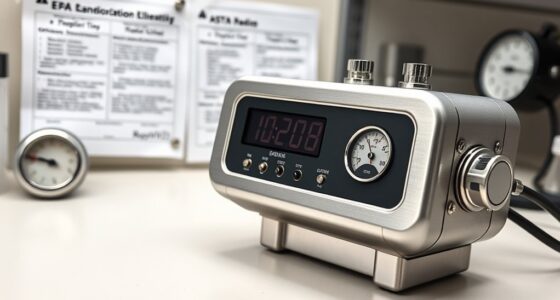To track air quality metrics for ESG and sustainability reporting, you should use sensors and monitors to measure indoor pollutants like VOCs and particulate matter continuously. Collect and analyze this data to identify emission sources and evaluate the impact of your mitigation efforts. Incorporate these metrics into your ESG reports to showcase your commitment to healthier environments. Staying proactive with indoor air quality management can lead to meaningful improvements—discover strategies to enhance your efforts further.
Key Takeaways
- Deploy sensors and monitors for continuous, real-time indoor air quality data collection.
- Track pollutant levels such as VOCs, particulate matter, and carbon monoxide to assess indoor environment health.
- Incorporate air quality metrics into ESG reports, demonstrating transparency and progress toward emission reduction goals.
- Set specific targets (e.g., VOC reduction percentages) and document improvements over time for accountability.
- Use indoor air quality data to inform and refine emission reduction strategies, supporting sustainable building management.

Have you ever wondered how companies measure their impact on air quality within their ESG (Environmental, Social, and Governance) strategies? It’s a vital question, especially as stakeholders increasingly demand transparency regarding environmental performance. One key aspect is understanding indoor pollutants, which can considerably affect employee health and overall building sustainability. Indoor pollutants include volatile organic compounds (VOCs), particulate matter, carbon monoxide, and other airborne contaminants that originate from building materials, cleaning products, or even office equipment. Monitoring these pollutants isn’t just about compliance; it’s about creating healthier work environments and reducing the company’s overall environmental footprint. To effectively track indoor air quality, companies often deploy sensors and air quality monitors that continuously measure pollutant levels. These devices provide real-time data, allowing organizations to identify sources of indoor pollutants and implement targeted emission reduction strategies. For example, upgrading ventilation systems, switching to eco-friendly cleaning supplies, or modifying building materials can drastically cut indoor emissions. This proactive approach not only improves health outcomes but also aligns with broader emission reduction goals, demonstrating a company’s commitment to sustainable practices. Additionally, incorporating air quality metrics into regular reporting helps organizations maintain accountability and motivate ongoing improvements. Emission reduction, in this framework, becomes a tangible metric for ESG reporting. Companies can quantify their efforts by documenting decreases in indoor pollutant levels over time. This data provides concrete evidence of their commitment to healthier indoor environments and reduced environmental impact. Many organizations set specific targets, such as lowering VOC concentrations by a certain percentage within a year, and track progress through regular monitoring. These efforts contribute to an extensive ESG report that highlights actionable steps taken towards emission reduction and sustainable building operations. Additionally, tracking indoor pollutants offers insights into the effectiveness of existing protocols and investments. If pollutant levels remain high despite intervention, it signals the need for further measures or alternative solutions. Furthermore, integrating indoor air quality metrics into sustainability reporting reflects a holistic approach to environmental responsibility. It shows that a company isn’t just focused on external emissions from vehicles or manufacturing but also on internal factors that directly influence employee well-being and energy efficiency. By measuring and actively managing indoor pollutants, you’re demonstrating a commitment to emission reduction that benefits both the environment and your workforce. This transparency fosters trust among stakeholders, investors, and customers who increasingly prioritize sustainability. In short, understanding and controlling indoor pollutants is an essential part of tracking air quality metrics for ESG, helping companies meet their environmental goals while promoting healthier spaces for everyone involved.
Frequently Asked Questions
How Do Companies Choose Which Air Quality Metrics to Report?
You choose air quality metrics based on your company’s operations, regulatory requirements, and stakeholder expectations. Focus on air quality monitoring data that accurately reflects your emissions and impacts. Prioritize transparency by selecting metrics that demonstrate your commitment to data transparency and sustainability. Consider industry standards and best practices to guarantee your reporting is thorough, credible, and aligned with ESG goals. This approach helps build trust and showcases your environmental responsibility.
What Are the Challenges in Standardizing Air Quality Data?
Did you know that over 70% of air quality sensor data faces calibration issues? Standardizing air quality data is tough because different sensors may produce inconsistent results. You need to guarantee proper data calibration, but variations in sensor types and locations complicate this process. These challenges hinder creating uniform, comparable air quality metrics, making it difficult for companies to accurately report and improve their ESG and sustainability efforts.
How Does Air Quality Data Impact Investor Decisions?
Air quality data impacts your investor decisions by highlighting how companies manage environmental risks through air quality indicators. When data transparency is high, you’re better equipped to assess a company’s sustainability practices and potential liabilities. This information influences your confidence in investments, as strong air quality management signals responsible operations. Ultimately, clear, reliable air quality data helps you make more informed, sustainable investment choices aligned with ESG goals.
Are There Specific Regulations Guiding Air Quality Reporting?
You’ll find that specific regulations guide air quality reporting, making regulatory compliance vital. These rules often require data harmonization to guarantee consistency across reports and jurisdictions. When you align your data with regulatory standards, it not only simplifies compliance but also enhances transparency. This coincidence of regulatory requirements and data harmonization helps you meet ESG goals more effectively, showing investors and stakeholders your commitment to environmental responsibility and sustainable practices.
How Can Companies Improve Their Air Quality Measurement Accuracy?
You can improve your air quality measurement accuracy by investing in advanced air monitoring technology and regularly calibrating your data collection instruments. Consistent data calibration guarantees your measurements remain precise over time. Additionally, using high-quality sensors and conducting routine maintenance helps detect and correct errors, leading to more reliable data. This proactive approach supports better ESG reporting and demonstrates your commitment to sustainability and regulatory compliance.
Conclusion
So, next time you’re bragging about your company’s green initiatives, remember: tracking air quality metrics isn’t just a box to check. It’s the real test of your ESG commitment—yet somehow, it’s often the last thing on the agenda. Ironically, the air we breathe is the most obvious indicator of sustainability, yet it’s frequently overlooked. If you want credibility, start paying closer attention now—before the next report makes it painfully clear you’ve been missing the point.










